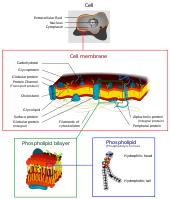
Photo from wikipedia
Of the single-celled eukaryotic microbes, Naegleria fowleri, Balamuthia mandrillaris, and Acanthamoeba spp. are known to cause fatal encephalitis in humans. Being eukaryotes, these cells have been used as a model… Click to show full abstract
Of the single-celled eukaryotic microbes, Naegleria fowleri, Balamuthia mandrillaris, and Acanthamoeba spp. are known to cause fatal encephalitis in humans. Being eukaryotes, these cells have been used as a model for studying and understanding complex cellular processes in humans like cell motility, phagocytosis, and metabolism. The ongoing pandemic caused by SARS-CoV-2 that infects multiple organs has emerged as a challenge to unravel its mode of infection and the pathogenicity resulting in eukaryotic cell death. Working with these single-celled eukaryotic microbes provided us the opportunity to plan bioinformatic approaches to look into the likelihood of studying the known and alternative mode of infection of the SARS-CoV-2 in eukaryotic cells. Genome databases of N. fowleri, B. mandrillaris, and Acanthamoeba spp. were used to explore the expression of angiotensin-converting enzyme 2 (ACE2), androgen-regulated serine protease precursor (TMPRSS2), CD4, CD147, and furin that are known to be cardinal for SARS-CoV-2 in recognition and binding to human cells. It was hypothesized that if a receptor-dependent or phagocytosis-assisted SARS-CoV-2 uptake does occur in free-living amoebae (FLA), this model can provide an alternative to human cells to study cellular recognition and binding of SARS-CoV-2 that can help design drugs and treatment modalities in COVID-19. We show that, of the FLA, ACE2 and TMPRSS2 are not expressed in Acanthamoeba spp. and B. mandrillaris, but primitive forms of these cell recognition proteins were seen to be encoded in N. fowleri. Acanthamoeba spp. and N. fowleri encode for human-like furin which is a known SARS-CoV-2 spike protein involved in host cell recognition and binding.
Journal Title: ACS chemical neuroscience
Year Published: 2020
Link to full text (if available)
Share on Social Media: Sign Up to like & get
recommendations!